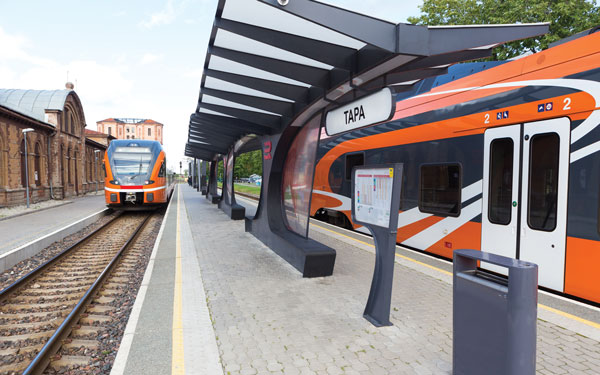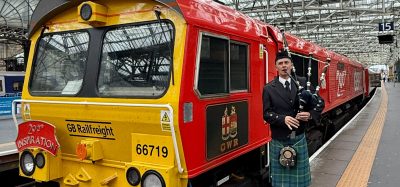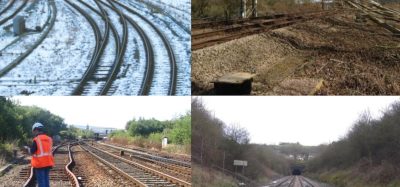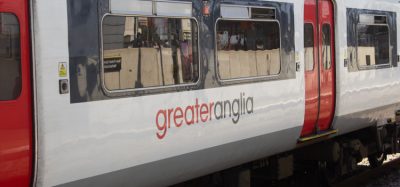Vital Estonian infrastructure renovation to ensure safety and quality
Posted: 23 March 2016 | | No comments yet
On 5 November 2015 railways in Estonia celebrated their 145th anniversary. Over the course of nearly one and a half centuries, Estonia has seen various governments in power and different principles, technology and tools employed in railway construction. With some important repairs already finished, Sulev Loo, Chairman of the Management Board – General Director of Estonian Railways Ltd., highlights what is next on the list of projects to bring more of its infrastructure up-to-date…


Over the past decade 320 of Estonian Railways’, 225km of railways have undergone major repairs. All passenger waiting platforms have been refurbished, plus tracks, overhead contact lines and the automated equipment of level crossings have been repaired thoroughly. However, a portion of the existing railway today still dates from the 1960s.
In the course of the next few years, railway repairs on southbound and westbound lines will play an important role in ensuring the safety and quality of traffic. The railway is being reconstructed on the Tapa–Tartu line, with Stage II major repairs beginning on the Tallinn–Keila–Paldiski and Keila–Riisipere lines.
The investment priority for the project is to connect environmentally-friendly, low-noise and low-carbon transport systems (including inland waterways, maritime transport, ports and various other transport modes), and to develop and improve airport infra – structure in order to promote sustainable regional and local mobility. The objective of the projects is sustainable transport, including rail transport in the TEN-T network.
The southbound Tapa–Tartu line is important for passenger transport between Estonia’s two largest cities, and for freight transport to and from Russia and Latvia to be able to function via Koidula Station. Repairs on the Tapa–Tartu line began in 2015 and will continue through 2017.
Repairs on the railway section from Tallinn to Tapa ended in 2012, completing a major project that had taken four years and saw a total of 112.8km reconstructed. The bulk of the work consisted of major railway repairs on main open track (60.5km) and on station gridiron (20.2km). In addition, the track bed was cleaned, plus sleepers and 114 turnouts were replaced.
The westbound electrified Tallinn–Keila–Paldiski and Keila–Riisipere lines with busy passenger train traffic also support freight transport to Paldiski Harbour. Stage II major repairs on this line will begin during 2016 and end in late-2018. Stage I major repairs on the same line were carried out from 2011 to 2013.
Repairs on the southbound line: Tapa–Tartu line
The Tapa–Tartu segment is part of the Tallinn–Tapa–Tartu–Koidula line which is part of the TEN-T core network, supporting passenger transport from Tallinn to Tartu and freight transport from Tallinn to Russia. In addition, the overall TEN-T network includes the Tartu–Valga section, which supports passenger and freight transport from Tallinn to Valga. Sections undergoing repairs lie along the 112.5km stretch between Tapa and Tartu, of which slightly more than half is being repaired.
Due to rail wear, rail defects, unserviceable sleepers and areas of contaminated track bed, speed had been limited on 41%, or 23.5km, of the total 57km-long section in order to ensure safety. A speed limit of up to 50km/h introduced in places extended the travel time for both passenger and freight trains, whilst significantly reducing capacity. In total, the travel time became longer by at least 20 minutes for passenger trains and by at least 40 minutes for freight trains, compared to the travel speeds sought (120km/h and 80km/h, respectively).
The reconstruction of the Tapa–Tartu railway aims to ensure traffic safety and the continuity of operation, reduce the number of speed limits and allow travel speeds of up to 120km/h for passenger trains and up to 80km/h for freight trains.
The project has a total scope of 57km of major repairs on open track and main station gridiron. The major works will include the replacement of the entire railway superstructure (track bed, rails and sleepers), an expansion of the track formation and an increase in load-bearing capacity, if necessary, as well as repairs on level crossings, with drainage facilities constructed or cleaned. Superstructure repairs will deploy crushed granite and reinforced concrete sleepers with flexibly mounted type 60E1 jointless track. The jointless track is welded together, resulting in a railway with low noise and vibration levels, on which design travel speeds of up to 120km/h will be restored.
2015 saw the completion of 12km of the section under repairs, with 35km and 10km of railways to be upgraded in 2016 and 2017, respectively.
In order to improve traffic safety and gradually increase passenger train speeds in the future, all the automated signalling systems at level crossings on the Tapa–Tartu section will need to be modernised with broken lights being replaced.
Continuing during 2016, automated signalling at level crossings on the Tapa–Tartu line will be modernised. As part of the project, the existing signalling at level crossings will be supplemented with barriers to ensure the highest possible level of safety. A total of 16 level crossings are being upgraded. Once the automated signalling at level crossings has been supplemented with barriers, the speed limit on the aforementioned line will be increased to 135km/h.
To ensure the seamless operation of Estonian Railways’ telecommunications, the fibre-optic cable runs will be backed-up on the Tapa–Tartu line in 2016. In 2017 fibre-optic cable runs will be backed-up on the eastbound Tapa–Narva line.
Repairs on the westbound line: Tallinn–Keila–Paldiski line
The Tallinn–Keila–Paldiski railway supports passenger and freight transport, whereas the Keila–Riisipere section mostly supports westbound passenger transport from and to Tallinn in Harju County. An electrified rail track extends from Tallinn west to Keila, where it splits into two branches – one runs to Paldiski, where the harbour handles freight transport, and the other runs to Riisipere. The line to Paldiski, in turn, splits at Klooga, from where travel is possible to Kloogaranna.
The length of the railway section covered by the project is 75.5km and is part of the electrified railway linking the cities of Keila and Paldiski, and the settlement of Riisipere to the capital. Today the project railway section is mainly used for passenger train traffic: more than 96% of the train kilometres travelled on this section are travelled by passenger trains.
The project aims to ensure traffic safety and the continuity of operation on the Tallinn–Keila–Paldiski and Keila–Riisipere sections, reduce the number of speed limits and resume the works from Stage I carried out in 2012 and 2013. The major repairs on the Tallinn–Keila–Paldiski and Keila–Riisipere lines during Stage I included repairs of six stretches of open track totalling 47km. Repairs were undertaken on the open track in the worst condition on this line. Additionally, pavement was replaced on nine level crossings. Neither repairs on station gridiron (including main station gridiron) and some open track, nor replacements of main track turnouts, were completed.
Currently, the situation is critical at the Keila, Klooga, Paldiski, Vasalemma and Riisipere stations on the lines to Paldiski and to Riisipere due to the poor technical condition of the railway infrastructure. The railway superstructure (rails, sleepers, track bed and turnouts) have become damaged, with the railway geometry considerably exceeding the permissible values. Due to defects, the geometry of turnouts has become critical in several places, with maintenance repairs resulting from the defects potentially paralysing train traffic along the entire section. The current situation, with regard to speeds, is already critical in several locations. Speeds on main station gridiron are mostly 40km/h, with speed limits of 25km/h in effect in some places. If poor condition is resulting in the number of defects, it makes sense to introduce a lower speed for the entire station gridiron. This, however, directly affects whether trains run on time. Most speeds set for station gridiron range from 5km/h to 25km/h; 5km/h is the lowest speed that can be introduced, but in the event of any additional defects there will be a risk of station gridiron closure.
Major repairs are scheduled to occur at stations on the Tallinn–Keila–Paldiski and Keila–Riisipere lines, with sections during Stage I that were not reconstructed totalling approximately 42km. The major repairs work will include the replacement of the entire railway superstructure (track bed, rails and sleepers), an expansion of the track formation and an increase in its load-bearing capacity, if necessary, as well as repairs on level crossings, with drainage facilities constructed or cleaned, plus all main track turnouts being replaced. Superstructure repairs will deploy crushed granite and reinforced concrete sleepers with flexibly mounted, type 60E1 jointless track. The jointless track is welded together, resulting in a railway with low noise and vibration levels.
This project is currently in the preparations stage (with project and technical documentation and procurements being prepared). Works are scheduled to begin in the second half of 2016.
Between 2016 and 2019 the replacement of electricity centralisations on the Tallinn–Keila, Keila–Paldiski and Keila–Riisipere lines will also begin. As a result of the implementation of the project, trips will begin to be set automatically and the existing Tallinn–Tapa CTC will be merged with the new traffic control system to ensure the smoothest possible organisation of train traffic in the immediate vicinity of Tallinn.
Overhead contact lines
The beginning of 2016 saw the completion of a four-year major project to upgrade overhead contact lines1.
The reconstruction of overhead contact lines aimed to assure quality conditions for the provision of passenger train services using the new Stadler Flirt trains (the entire fleet of passenger trains was replaced in the summer of 2013) and the conformity of the railway overhead contact lines for operating the new trains in accordance with the applicable technical requirements. Furthermore, conditions were created for an increase in passenger traffic intensity and speeds in the future. The project was divided into the following three parts:
- Reconstruction of overhead contact lines
- Reconstruction of freight substations at Järve and Keila
- Purchase of a maintenance vehicle for overhead contact lines.
Overhead contact lines on the Tallinn–Paldiski and Keila–Vasalemma lines were built from 1958 to 1964. No major repairs were undertaken during the exploitation phase, as a result of which reinforced concrete supports, load-bearing structures, load-bearing cables and mounting assemblies for overhead contact lines needed to be replaced. Accordingly, owing to the non-replacement of overhead contact lines, it would not have been possible for electric train traffic to continue going forward, so this project was a precondition for the continued operation of electric trains.
Renovation of overhead contact lines included the replacement of all the elements of overhead contact lines, including load-bearing supports and structures, cables and wires, insulators and other line equipment; a total of 84km of electrified railways, or 38% of the total length of electrified railways in Estonia. Overhead contact lines were reconstructed for speeds allowing passenger trains to potentially travel at up to 160km/h on main tracks. Solutions were used to reduce the costs and time required by the maintenance and repairs of overhead contact lines going forward.
Traction substations
The traction substations at Järve and Keila feeding overhead contact lines were built over 50 years ago; the equipment mostly dated from the 1960s, conforming to the technological designs in effect at the time. Due to the ageing and degradation of the equipment, it was difficult to provide the overhead contact lines and railway with a steady power supply. The works undertaken will result in fully upgraded traction substations at Keila and Järve that conform to all the applicable requirements.
As part of the renovation of traction substations, all equipment was replaced and installed inside new purpose-built structures. One of the aims of the reconstruction was to improve voltage quality in overhead contact lines in conjunction with the launch of new, more powerful electric trains.
The works included the construction of new buildings, the installation of new switchgear, connected to the existing lines, and the disassembly of old switchgear. Switchgears – 35, 10 and 3 kilovolts – were built at the new, more reliable and more compact traction substation. In a major change, 35 kilovolt outdoor switchgear was replaced with indoor switchgear inside the new substation building, and rectified current sources were transferred to a 12-pulse system to increase electricity quality in overhead contact lines, and the utilisation of elegas (SF6) to enable the installation of compact switchgear of reduced dimensions.
To ensure the sustainability of the results of the project, a maintenance vehicle was purchased to conduct checks, maintenance and repairs on overhead contact lines. The maintenance vehicle for overhead contact lines makes it possible to ensure the undisrupted operation of overhead contact lines and the speedy restoration of traffic in the event of faults or breakdowns in overhead contact lines. The project concluded in early-2015.
Reference
- ‘Reconstruction of the overhead contact lines of electrified railway lines’, co-financed by the European Union Cohesion Fund.
Biography
Sulev Loo has extensive management experience in the international transit and logistics sector. He has been in charge of many big Estonian transit and logistics companies, such as N-Terminal Group, Milstrand Ltd, Pakterminal Ltd, and Tarcona Ltd. Since 1 September 2015, Sulev has been the Chairman of the Management Board – General Director of Estonian Railways Ltd.
Stay Connected with Global Railway Review — Subscribe for Free!
Get exclusive access to the latest rail industry insights from Global Railway Review — all tailored to your interests.
✅ Expert-Led Webinars – Gain insights from global industry leaders
✅ Weekly News & Reports – Rail project updates, thought leadership, and exclusive interviews
✅ Partner Innovations – Discover cutting-edge rail technologies
✅ Print/Digital Magazine – Enjoy two in-depth issues per year, packed with expert content
Choose the updates that matter most to you. Sign up now to stay informed, inspired, and connected — all for free!
Thank you for being part of our community. Let’s keep shaping the future of rail together!







